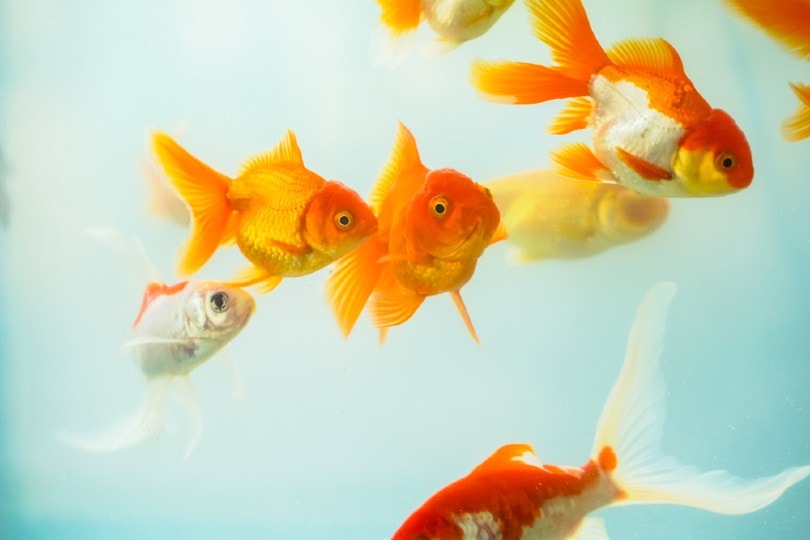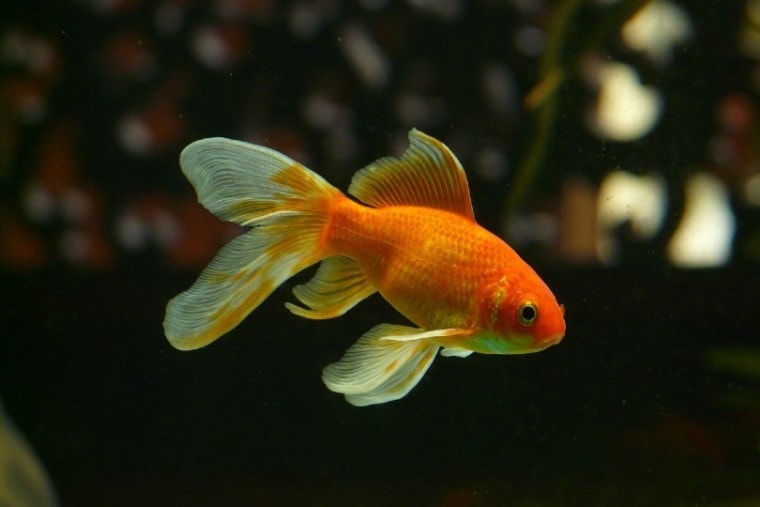
The superb Veiltail is a rare variety of goldfish, easily confused with the more common Fantail. This freshwater fish needs plenty of room to swim freely and is a great tank mate for other varieties of fancy goldfish. However, in addition to being difficult to find in pet stores, the Veiltail is hard to breed and is aimed at experienced aquarists.
Read on to discover all the facets of these splendid colorful fish!
Quick Facts About Veiltail Goldfish
| Species Name: | Carassius auratus auratus |
| Family: | Cyprinidae |
| Care Level: | Moderately Difficult |
| Temperature: | Between 65°F and 72°F |
| Temperament: | Peaceful |
| Color Form: | Orange, red, metallic, and many other colors are possible |
| Lifespan: | 10 – 15 years |
| Size: | 7 inches |
| Diet: | Omnivore |
| Minimum Tank Size: | 20 gallons |
| Tank Set-Up: | Freshwater, bushy plants, no objects with sharp points |
| Compatibility: | Other goldfish, peaceful species |
Veiltail Goldfish Overview
Veiltails are beautiful fancy goldfish, popular for their appearance but rare and difficult to breed. They are one of 125 varieties of fancy goldfish that are only bred in captivity.
The Veiltail goldfish was developed from the double-tailed, slender-bodied Japanese Wakin goldfish. This dainty-finned, veiled-tailed, shimmeringly colored fish first appeared in Philadelphia in the late 1800s.
These slow-moving, peaceful fish can reach 7 inches in length and live for up to 15 years if kept in optimal conditions. They need plenty of free-swimming space, are prone to fungal and bacterial infections, and their beautiful fins can be easily damaged on sharp, rough aquarium fixtures.
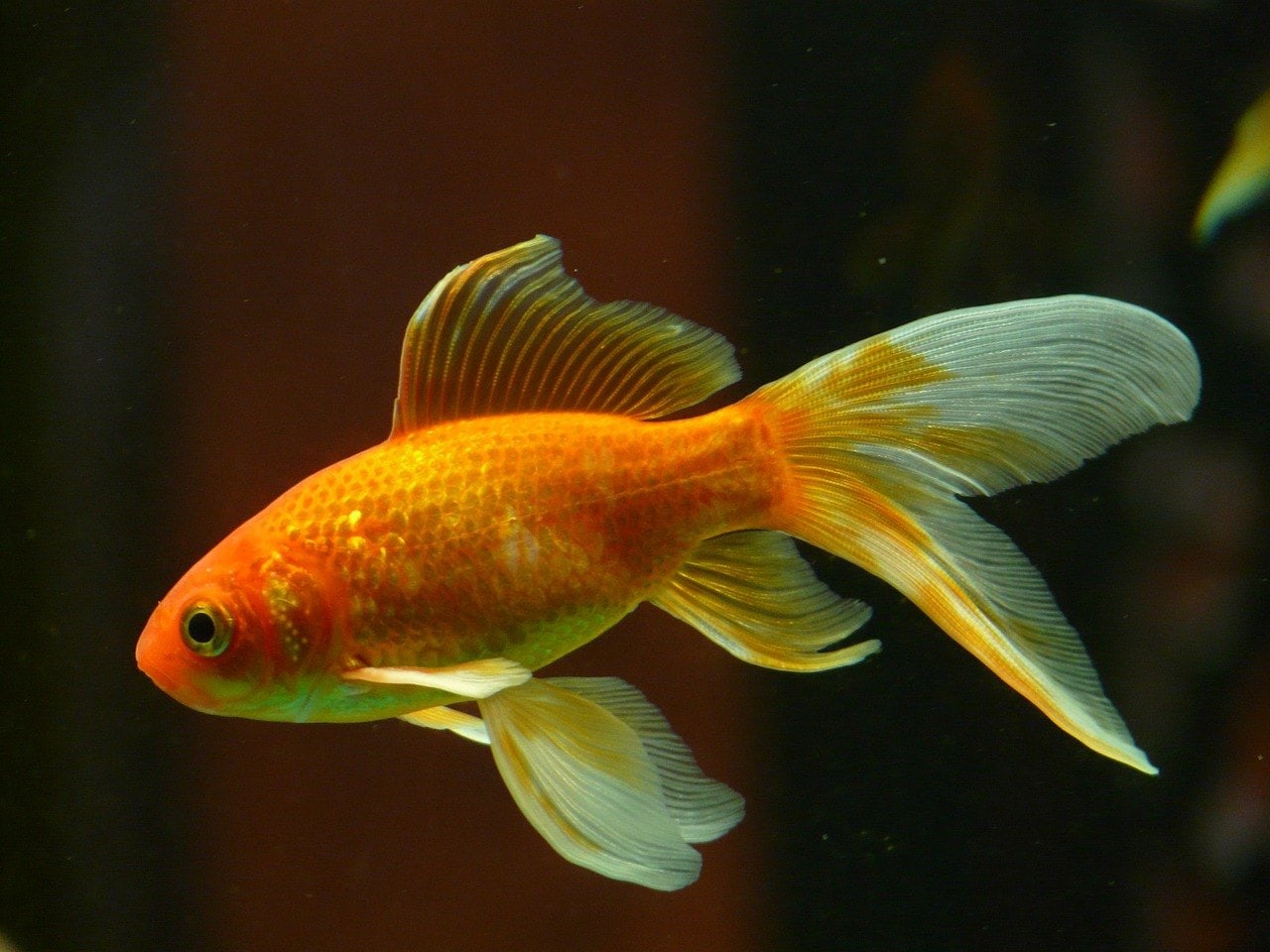
How Much Do Veiltail Goldfish Cost?
Veiltail goldfish are rare, expensive, and hard to find in pet stores. If you manage to find a breeder, expect to pay between $40 and $50 per individual, or even more. Also, be careful not to confuse it with the Red Fantail goldfish, which is easily found in pet stores and is sold between $5 and $20.
Typical Behavior & Temperament
The Veiltail goldfish is a peaceful tank companion, loves swimming in groups, and gets along well with other non-aggressive varieties of fancy goldfish. Despite its sail-like tail, this fish does not swim very quickly and can therefore run out of food if you place it in the same tank with faster species. However, the Veiltail is a good scavenger and quite active during the day.
Appearance & Varieties
Veiltail goldfish are sometimes confused with Fantail goldfish, although they have long, thin, and translucent fins and tails. The Veiltail’s dorsal fin, which can grow up to 2 inches tall, helps differentiate the two varieties.
Veiltails goldfish have stunning metallic sheen scales, mostly in shades of red and orange. They have an egg-shaped body, a large head, and big protruding eyes. Furthermore, males and females are very similar, both in color and size, although the male is noticeably smaller than the female. A good trick to tell them apart is to see if the male has small, light-colored growths on his gills.
How to Take Care of Veiltail Goldfish
Habitat, Tank Conditions & Setup
Don’t neglect tank set-up if you want to successfully breed Veiltail goldfish. They have specific living conditions and are prone to developing diseases, so you must take care to maintain optimal aquarium conditions. On the one hand, these scavenger fish produce a lot of waste and constantly stir the bottom of the water when they feed.
Moreover, Veiltail goldfish need a lot of oxygen: it is, therefore, essential to install a good water filtration system, preferably biological (for example, by amply decorating the aquarium with bushy and oxygenating aquatic plants). This makes it easier to maintain the water quality of the tank, reducing detritus and organic waste from the fish.
Tank Size
You must have a tank of at least 10 gallons to accommodate a Veiltail goldfish, but the ideal size is 20 gallons per fish, so they can swim freely and explore their aquatic environment.
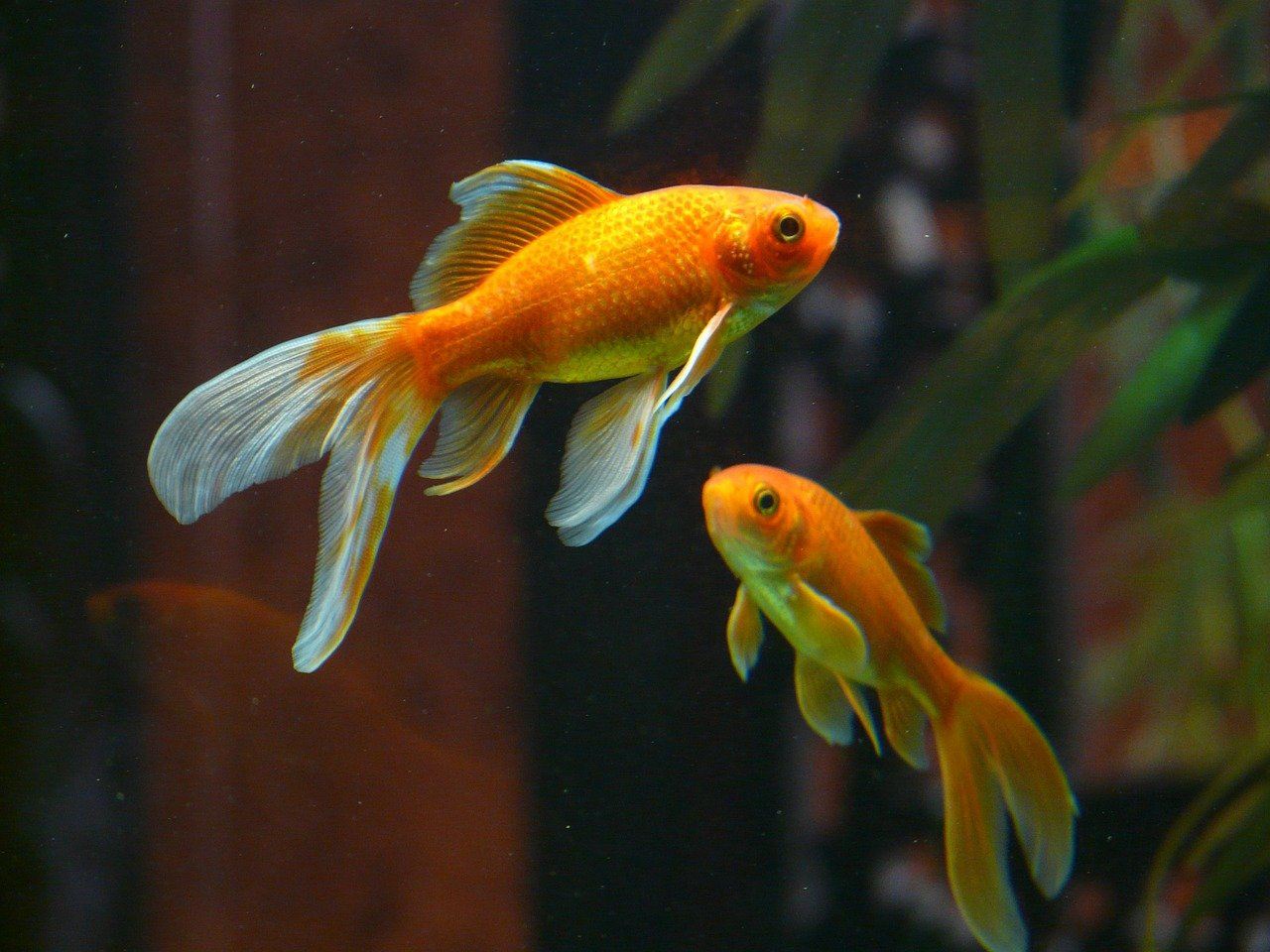
Water Quality & Conditions
Veiltail goldfish need cool water between 65°F and 72°F. They can tolerate colder temperatures, especially in winter before the spawning period, but their tank should not drop below 50°F.
Water pH should be between 6.0 and 8.0, water hardness between 5 and 19 dGH, and ammonia and nitrite levels should be zero.
In order to measure tank water parameters regularly and above all, to make your life easier, consider buying a good all-around tester kit.
Substrate and Plants
Gravel substrate, smooth rocks, and aquatic plants help create a natural and suitable environment for Veiltail goldfish. Avoid putting decorative objects with sharp and rough sides, otherwise, your fish may damage their delicate fins.
Lighting
Provide moderate lighting for your goldfish. If your aquarium comes with lighting built into the lid, that will be more than enough. You can also place the tank near a window, which will provide a nice source of natural light for aquatic plants.
Filtration
Veiltail goldfish produce a lot of waste. A good water filtration system should contain mechanical and biological filter media to remove organic waste and increase water oxygenation.
Are Veiltail Goldfish Good Tank Mates?
Veiltail goldfish are peaceful and sociable: they thrive in groups and make excellent tank mates, as long as the other species is also peaceful.
The best tank mates for the Veiltail Goldfish are the Telescope Goldfish, Celestial Goldfish, and Lionhead Goldfish.
Do not keep your Veiltails with other varieties of slim-bodied goldfish, as these are generally faster swimmers. As a result, the slower, less agile Veiltails risk running out of food.
Also, don’t keep Veiltails with fish with fin clips. Fin-nipping fish can damage the delicate fins and tails of the Veiltail. Finally, tetras and bettas, which are usually aggressive and territorial, are not at all suitable tankmates for placid Veiltail goldfish.
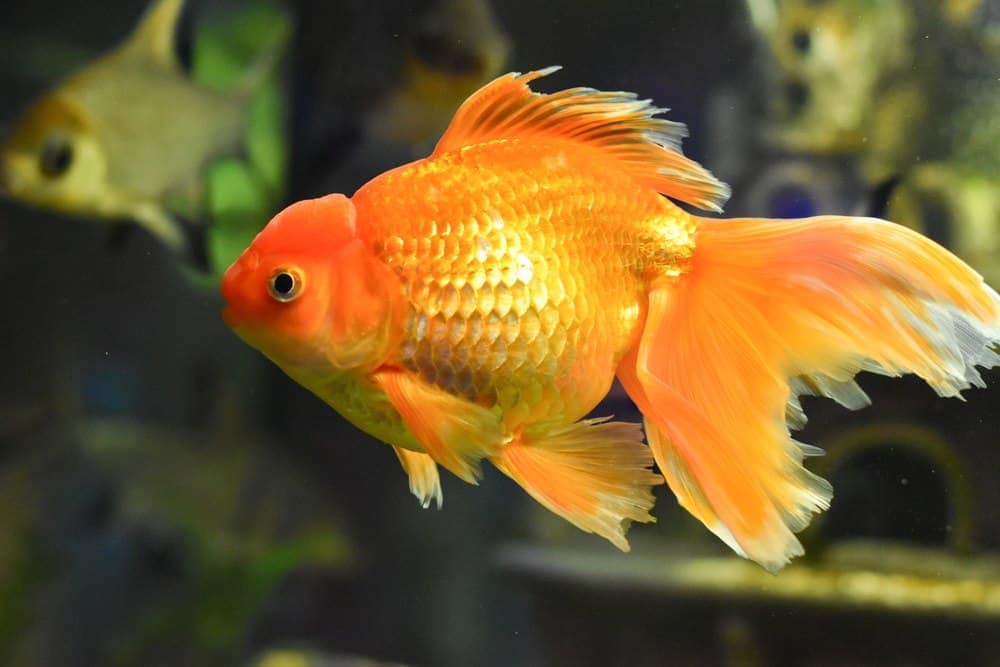
What to Feed Your Veiltail Goldfish
Goldfish of all species are omnivores and need a diverse, protein-rich diet: fish flakes, bloodworms, brine shrimp, other live or frozen small invertebrates, and plant-based foods that you can easily find in pet stores.
Don’t overfeed your Veiltail: they are real gluttons and will eat non-stop if you let them. Feed them twice a day for just one minute.
Keeping Your Veiltail Goldfish Healthy
Goldfish are generally quite hardy and able to adapt to harsher conditions. After all, goldfish are considered the world’s worst invasive aquatic species when released into waterways by careless people! However, this is not the case with Veiltail: this variety is delicate and susceptible to diseases, bacteria, and infections. These are other reasons why Veiltails are difficult to breed.
These fish are prone to, among other things, swim bladder disorder, fin injuries (caused by other fish or sharp, rough objects found in the aquarium), white spot disease (often referred to as “Ich”), and other bacterial and fungal infections.
To limit these problems, clean the tank frequently, change the water regularly, avoid introducing new fish without quarantining them first, and be on the lookout for some typical symptoms of bacterial infections:
Breeding
Veiltail goldfish are considered a challenge to breed. Ideally, you should have a ratio of one female to two males in a tank of at least 20 gallons. You should also mimic conditions found in the wild as much as possible to encourage spawning. Also, be aware that Veiltail goldfish spawn when the water gets warmer in the springtime:
If spawning conditions are optimal, the female can lay up to 10,000 eggs, which will then be fertilized by the males. Then it is advisable to remove the parents and place them in a separate tank so that they do not devour all their eggs. The fry will hatch a few days later and can be put out with larger fish when they have reached at least 1 inch in length.
Are Veiltail Goldfish Suitable For Your Aquarium?
Veiltail goldfish are graceful and peaceful little creatures, which make good tank mates for other fancy goldfish. However, it is a rare and difficult variety to keep, especially for novice aquarists. They need very specific tank conditions and are more susceptible to disease and bacteria than other varieties of goldfish. In addition, their beautiful but delicate tail can easily be damaged by other fish or sharp objects.
Still, if you’ve done your research beforehand, have a tank of at least 20 gallons, an excellent water filtration system, and compatible goldfish species tank mates, then keeping Veiltail goldfish could be a formidable and rewarding challenge.
Featured Image Credit: Hans Braxmeier, Pixabay



